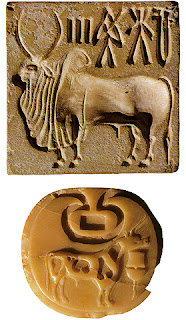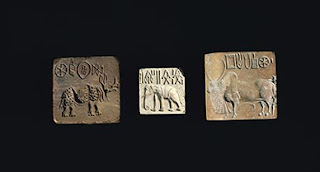Harappa
Harappa (
Urdu/
Punjabi:
ہڑپہ,
pronounced [ɦəɽəppaː]) is an
archaeological site in
Punjab, northeast
Pakistan, about 35 km (22 mi) west of
Sahiwal. The site takes its name from a modern village located near the former course of the
Ravi River. The current village of Harappa is 6 km from the ancient site. Although modern Harappa has a train station left from the British times, it is today just a small (pop. 15,000) crossroads town.
The site of the ancient city contains the ruins of a
Bronze Age fortified city, which was part of the
Cemetery H culture and the
Indus Valley Civilization, centered in
Sindh and the
Punjab.
[1] The city is believed to have had as many as 23,500 residents—considered
large for its time.
The ancient city of Harappa was greatly destroyed under the British Raj, when bricks from the ruins were used as track ballast in the making of the Lahore-Multan Railroad.
In 2005, a controversial
amusement park scheme at the site was abandoned when builders unearthed many archaeological artifacts during the early stages of construction work. A plea from the prominent Pakistani archaeologist
Ahmed Hasan Dani to the Ministry of Culture resulted in a restoration of the site
History
The
Indus Valley Civilization (also known as Harappan culture) has its earliest roots in cultures such as that of
Mehrgarh, approximately 6000 BCE. The two greatest cities,
Mohenjo-daro and Harappa, emerged circa 2600 BCE along the
Indus River valley in
Punjab and
Sindh.
[3] The civilization, with a
writing system, urban centers, and diversified
social and
economic system, was rediscovered in the 1920s after excavations at
Mohenjo-daro (which means "mound of the dead") in Sindh near
Sukkur, and Harappa, in west
Punjab south of
Lahore. A number of other sites stretching from the
Himalayan foothills in east
Punjab,
India in the north, to
Gujarat in the south and east, and to
Balochistan in the west have also been discovered and studied. Although the archaeological site at Harappa was partially damaged in 1857
[citation needed] when engineers constructing the
Lahore-
Multan railroad (as part of the
Sind and Punjab Railway), used
brick from the Harappa ruins for
track ballast, an abundance of artifacts has nevertheless been found.
Culture and economy
Indus Valley civilization was mainly an urban culture sustained by surplus agricultural production and commerce, the latter including trade with
Sumer in southern
Mesopotamia. Both
Mohenjo-daro and Harappa are generally characterized as having "differentiated living quarters, flat-roofed brick houses, and fortified administrative or religious centers."
[5] Although such similarities have given rise to arguments for the existence of a standardized system of urban layout and planning, the similarities are largely due to the presence of a semi-orthogonal type of civic layout, and a comparison of the layouts of
Mohenjo-daro and Harappa shows that they are in fact, arranged in a quite dissimilar fashion. The chert weights and measures of the Indus Valley Civilization, on the other hand, were highly standardized, and conform to a set scale of gradations. Distinctive seals were used, among other applications, perhaps for identification of property and shipment of goods. Although
copper and
bronze were in use,
iron was not yet employed. "
Cotton was woven and dyed for clothing;
wheat,
rice, and a variety of vegetables and fruits were
cultivated; and a number of animals, including the
humped bull, were
domesticated."
[5] Wheel-made pottery—some of it adorned with animal and geometric motifs—has been found in profusion at all the major Indus sites. A centralized administration for each city, though not the whole civilization, has been inferred from the revealed cultural uniformity; however, it remains uncertain whether authority lay with a commercial
oligarchy. There appears to be a complete lack of priestly "pomp or lavish display" that was common in other civilizations
















Multan, one of the major cities of Pakistan is known across the globe for its rich culture, Sufi shrines and historical sites. Looking for a house in Multan? Find house for sale in Multan on Graana.com- Pakistan's Smartest Property Portal. Search from thousands of verified listings.
ReplyDeleteMultan, one of the major cities of Pakistan is known across the globe for its rich culture, Sufi shrines and historical sites. Looking for a house in Multan? Find house for sale in Multan on Graana.com- Pakistan's Smartest Property Portal. Search from thousands of verified listings.
ReplyDeleteThe high quality content perfectly cover overall dimensions. The house prices Pakistan is much higher in these areas.
ReplyDeletereadable and worth content good work
ReplyDeletehttps://article-writing.info/
This comment has been removed by the author.
ReplyDeleteThank you for sharing such an amazing & informative article read more about famous & historical places in Pakistan.
ReplyDeletePakistan is a culturally diverse country with natural beauty, culture, cuisine, and, of course, historical sites. Pakistan offers it everything, from lush green plains to enormous mountain ranges and stunning deserts. People who enjoy visiting antique and historical sites would find Pakistan to be a wonderland. Various civilizations reigned over the nation. Throughout their excursions, several renowned persons travelled through the land. People from around the world travel to visit these historical places in Pakistan and enjoy these.
ReplyDelete